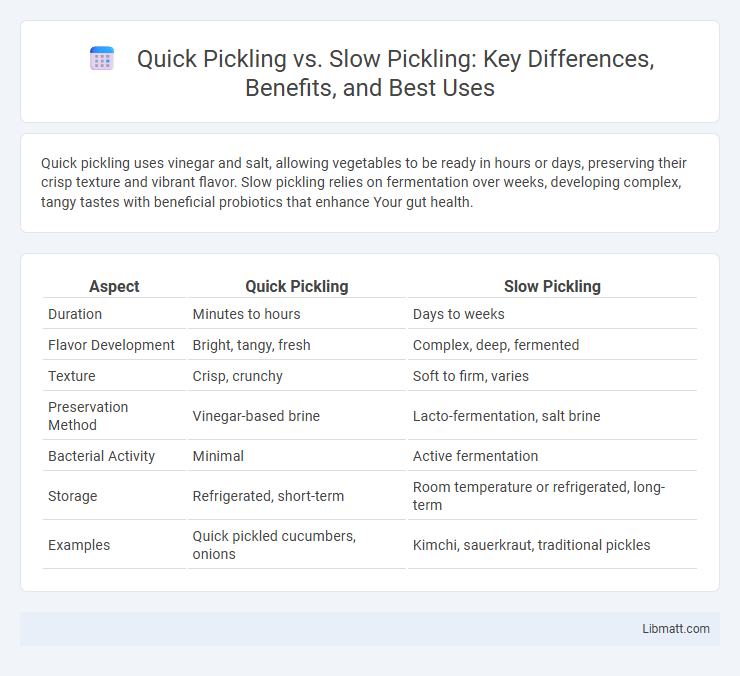Quick pickling uses vinegar and salt, allowing vegetables to be ready in hours or days, preserving their crisp texture and vibrant flavor. Slow pickling relies on fermentation over weeks, developing complex, tangy tastes with beneficial probiotics that enhance Your gut health.
Table of Comparison
| Aspect | Quick Pickling | Slow Pickling |
|---|---|---|
| Duration | Minutes to hours | Days to weeks |
| Flavor Development | Bright, tangy, fresh | Complex, deep, fermented |
| Texture | Crisp, crunchy | Soft to firm, varies |
| Preservation Method | Vinegar-based brine | Lacto-fermentation, salt brine |
| Bacterial Activity | Minimal | Active fermentation |
| Storage | Refrigerated, short-term | Room temperature or refrigerated, long-term |
| Examples | Quick pickled cucumbers, onions | Kimchi, sauerkraut, traditional pickles |
Introduction to Pickling Methods
Quick pickling uses a vinegar-based brine and typically takes a few hours to a few days, preserving crispness and bright flavors in vegetables. Slow pickling, or fermentation, relies on natural bacteria over several weeks, producing complex, tangy flavors and probiotics that benefit gut health. Choosing between the two methods depends on your desired taste, texture, and fermentation time.
What is Quick Pickling?
Quick pickling is a rapid preservation method using a vinegar-based brine that allows vegetables to be ready for consumption within hours to a few days. This process relies on acidity and often includes salt, sugar, and spices, creating a tangy flavor without the need for fermentation. Quick pickling maintains a crisp texture and bright taste, making it ideal for immediate use and fresh culinary applications.
What is Slow Pickling?
Slow pickling is a fermentation process where vegetables soak in a brine solution for several weeks to develop complex, tangy flavors and beneficial probiotics. Unlike quick pickling, which uses vinegar for immediate preservation, slow pickling relies on natural lactic acid fermentation to enhance texture and nutrition. Your choice of slow pickling can result in richly flavored, healthful pickles with a longer shelf life.
Key Ingredients Used in Each Method
Quick pickling relies on a brine of vinegar, water, salt, and sugar combined with spices such as mustard seeds, dill, and garlic to rapidly infuse flavor in a few hours to days. Slow pickling uses a saltwater brine that encourages natural fermentation by lactobacillus bacteria over weeks or months, enhancing complexity and acidity without vinegar. Key ingredients for slow pickling emphasize natural salt, water, and optional flavorings like bay leaves and peppercorns, while quick pickling incorporates acidic vinegar and sweeteners for immediate preservation and taste.
Time Differences: Fast vs. Traditional Pickling
Quick pickling typically requires only a few hours to a couple of days, utilizing a hot vinegar brine to rapidly preserve vegetables and infuse flavors, making it ideal for immediate consumption. Traditional slow pickling involves fermentation over several weeks to months, relying on natural bacterial activity to develop complex, tangy flavors and enhance probiotics. The time difference fundamentally impacts texture, taste complexity, and preservation method between quick and slow pickling.
Flavor Profiles: Tangy vs. Deeply Developed Tastes
Quick pickling results in tangy, bright flavors due to the short marination period and higher acidity levels, allowing the natural freshness of vegetables to shine. Slow pickling fosters deeply developed tastes as prolonged fermentation encourages complex interactions between microbes and ingredients, producing richer umami notes and mellow sourness. The choice between quick and slow pickling ultimately influences the intensity and depth of the final flavor profile.
Texture and Crunch: What to Expect
Quick pickling preserves a crisp texture by soaking vegetables in a hot vinegar brine for a short time, resulting in a crunchy bite ideal for fresh salads. Slow pickling involves fermenting vegetables over weeks, leading to a softer texture as natural lactic acid bacteria break down cell walls, producing a more tender crunch. Expect quick pickles to retain their firmness and vibrant snap, while slow pickles develop complex flavors with a mellow, chewy consistency.
Shelf Life and Storage Considerations
Quick pickling typically yields a shelf life of up to one month when stored in the refrigerator due to its lower vinegar concentration and lack of fermentation, making it ideal for short-term use. Slow pickling, often involving fermentation or higher acid content, extends shelf life to several months or even years when stored in cool, dark conditions such as a cellar or pantry. Proper storage for slow pickled products helps develop complex flavors while preventing spoilage and ensuring food safety over time.
Health Benefits and Nutritional Differences
Quick pickling preserves more of the natural vitamins, such as vitamin C and B vitamins, due to the shorter processing time, enhancing antioxidant intake while maintaining crisp texture and fresh flavor. Slow pickling fosters the growth of beneficial probiotics through extended fermentation, promoting gut health, improved digestion, and stronger immunity by increasing levels of lactic acid bacteria. Nutritionally, quick pickles tend to retain higher water-soluble nutrients, whereas slow pickling boosts probiotic content and bioavailability of minerals, making both methods valuable for different health benefits.
Choosing the Right Pickling Method for Your Needs
Quick pickling uses vinegar or brine and can preserve vegetables within hours to days, ideal for those seeking fast results and tangy flavors. Slow pickling relies on fermentation at room temperature or refrigeration over weeks to develop complex probiotic-rich flavors, suitable for enthusiasts prioritizing health benefits and depth of taste. Selecting the right pickling method depends on desired flavor intensity, preservation time, and nutritional advantages.
quick pickling vs slow pickling Infographic

 libmatt.com
libmatt.com